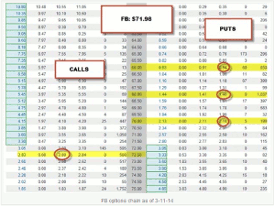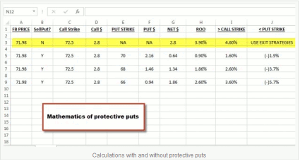Using the collar strategy as insurance for gap downs in a covered call position is a viable and sensible strategy, but one should be aware of both its advantages and disadvantages, says option expert Alan Ellman of TheBlueCollarInvestor.com.
Covered call exit strategies play a major role in mitigating losses in our BCI methodology. In most cases, we can keep losses to a minimum, turn losses into gains, and enhance profits as well. Some covered call writers want the security of protecting against a catastrophic gap-down, which can occur rarely. This can be accomplished by purchasing a protective put in what is known as the collar strategy. Here’s how it works:
The Collar Strategy
- Buy a stock
- Sell an out-of-the-money call option (strike higher than current market value)
- Buy an out-of-the-money put option (strike lower than current market value)
Goals of This Strategy
- Generate cash flow
- Protect against catastrophic price decline in the underlying security (advantage)
Disadvantages
- Lower returns
- Managing 3 positions instead of 2
Real-Life Example
In this article we will calculate the hypothetical returns using no puts in one case and evaluating three different strike prices for implementing the collar strategy with protective puts. I am using Facebook, Inc. (FB) in this example as it has been appearing on our premium watch list for several months, has decent returns, and several choices of strike prices. Here are the stats at the time I am writing this article:
Facebook Stats on 3-11-14
- Current price = $71.98
- Call strike selected = $72.50
- Put strikes to evaluate = $70, $68 and $66
We glean the following stats from this options chain:
- Short call generates $2.80
- $70 put costs $2.16
- $68 put costs $1.46
- $66 put costs $0.94
NEXT PAGE: Key Things to Watch
|pagebreak|The protective put gives us the right to sell at the strike price so the higher the strike, the greater the protection and the more expensive is the put. To determine our initial profit (ROO), we subtract the cost of the put from the cash generated from the sale of the call option ($2.80) and divide by our cost basis of $7198 per contract. From there, we can calculate returns if the share price moves above the call strike or moves below the put strikes. We will make the assumption that if no put is purchased, BCI members will employ our arsenal of exit strategies to manage our positions to maximum profits or minimum losses. Such strategies all start with buying back the option and frequently using our 20/10% guidelines. Next the calculations:
Spreadsheet using protective puts versus exit strategy management only.
It is impossible to make specific final determinations using the information provided in this hypothetical because so much depends on the skill of the investor in terms of using position management when indicated as well as the amount of price decline if the put is needed. But certain generalizations of interest can be made:
Conclusions
- The initial return not using protective puts is significantly higher than when using them (ROO column).
- If the share price closes above the call strike price (>call strike column), not buying a put produces the best results (4.60%)
- If the share price closes below the put strike, the smallest losses occur for the higher strike put prices but all still result in losses.
- Position management can also be used in the collar strategy but is more involved and may require more time because the investor is in 3, rather than 2, positions.
Commentary
Using protective puts or the collar strategy for covered call writers is a viable and sensible approach to this strategy. However, it does have its advantages and disadvantages. The main advantage is that the call writer is protected against catastrophic share depreciation below the put strike. The main disadvantage is that the profits generated from the sale of the call option will be substantially lower due to the debit resulting from the purchase of the put. The main reason for a stock price gap-down is a disappointing earnings report and we avoid those situations in our BCI methodology. However, unexpected bad news can come out at any time. Although that scenario is rare, some investors may prefer the protection afforded by protective puts. There is no right or wrong here. Each investor must make his (her) own determinations. I personally do not buy puts but have absolutely no problem with members who do.
By Alan Ellman of TheBlueCollarInvestor.com























